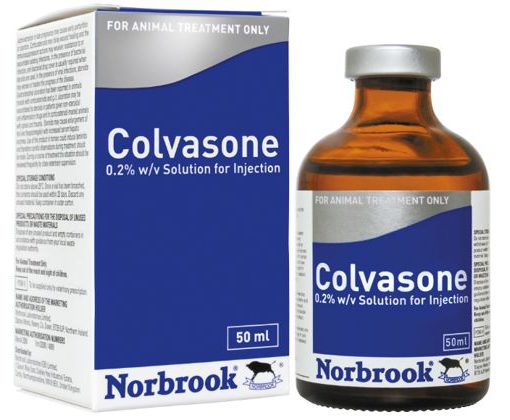For Animal Use Only
FLORCOL 450
Solution for Injection
Veterinary Systemic Antibacterial
COMPOSITION
Florcol 450 Solution for Injection is a light yellow, yellow clear sterile solution containing 450 mg of florfenicol per ml.
PHARMACOLOGICAL PROPERTIES
Florcol 450 Solution for Injection is a broad-spectrum synthetic bacteriostatic antibiotic. It inhibits protein synthesis by binding to the 70 S ribosomal subunits of bacteria. The main susceptible bacteria are:
Gram-positive bacteria: Actinomyces spp., Corynebacterium spp., Erysipelothrix rhusiopathie, Listeria monocytogenes, most Staphylococcus spp., and Streptococcus spp.
Gram-negative bacteria: Actinobacillus spp., Bordetella bronchiseptica, Enterobacteriaceae (E.coli, Klebsiella spp., Proteus spp., Salmonella spp.), Haemophilus spp., Leptospira spp., Moraxella spp., Pasteurella spp.
All anaerobes are generally susceptible. They are moderately active against Rhodococcus equi. Mycobacterium spp. and Nocardia spp. are resistant.
It is rapidly absorbed after intramuscular administration and reaches a serum concentration of 0.19 μg/ml 60 hours after administration. The protein binding rate varies between 12.7-18.3%. It is distributed throughout the body, especially in the lungs, liver, and kidneys. It is excreted from the body through urine and feces.
AREA OF USE / INDICATIONS
Florcol 450 Solution for Injection is used in the treatment of diseases caused by bacteria sensitive to florfenicol in cattle. In this context, it is used in respiratory tract infections caused by Mannheimia haemolytica, Pasteurella multocida, Haemophilus somnus, and Arcanobacterium pyogenes, in bacterial foot diseases such as foot rot, interdigital necrobacillosis and infectious pododermatitis caused by Fusobacterium necrophorum, Bacteroides meleninogenicus and Dichelobacter nodosus and in the treatment of infectious keratoconjunctivitis caused by Moraxella bovis.
USAGE AND DOSAGE
Unless advised otherwise by the Veterinarian,
Intramuscular administration:
The cattle are administered intramuscularly at a dose of 2 ml (20 mg/kg body weight) per 45 kg body weight. The dose should be repeated after 48 hours.
Subcutaneous application:
It is administered subcutaneously to cattle at a dose of 4 ml (40 mg/kg body weight) per 45 kg body weight. A single dose is sufficient for subcutaneous administration.
More than 10 ml should not be applied to the same area, if necessary, the dose should be divided. Injections should only be made from the neck area. When using, asepsis and antisepsis should be followed.
UNDESIRED EFFECTS
There may be a decrease in feed and water consumption after drug use.
A decrease in appetite may occur during treatment. However, after the end of the treatment, the appetite returns to normal in a short time. Local reactions may occur at the injection site, which may occur rarely and heal spontaneously.
DRUG INTERACTIONS
Incompatible with phenytoin, dicumarol, talbutamide, phenobarbital and pentobarbital.
RESIDUAL WARNINGS FOR FOOD PRODUCING ANIMALS
Drug Residue Elimination Period: During the treatment and after the last drug application, cattle raised for meat should not be sent to slaughter until 37 days after intramuscular applications and 64 days after subcutaneous applications. It should not be used in dairy cows producing milk for human consumption.
CONTRAINDICATIONS
Use in Pregnancy: Since its effects on pregnancy and reproduction have not been determined, it is not recommended to be used in breeding bulls and pregnant animals.
GENERAL PRECAUTIONS
Consult your veterinarian before use and in case of an unexpected effect. Keep out of reach of children.
Yellowing of the solution over time does not cause a loss of activity.
SYMPTOMS OF OVERDOSE, PRECAUTIONS, AND ANTIDOTE
The therapeutic index is very broad. With the consumption of 10-15 times higher doses of feed and water, a decrease in live weight gain, severe diarrhea, and dehydration can be seen. This picture improves rapidly with the discontinuation of the drug.
PRECAUTIONS TO BE TAKEN AND RECOMMENDATIONS FOR PHYSICIANS
In case of contact with the eyes or skin, wash the area with plenty of water. Avoid contact with the medicine and wash your hands after use.
STORAGE CONDITIONS AND SHELF LIFE
Store at room temperature (15-25°C) protected from light. Shelf life is 2 years from the date of manufacture. The drug, which is opened for first use, should be consumed within 28 days under the recommended storage conditions.
TRADE DRESS
It is offered for sale in transparent glass bottles of 20, 50, 100, and 250 ml in cardboard boxes and transparent plastic vials of 100, 250, and 500 ml.
PLACE AND CONDITIONS OF SALE
Sold in veterinary offices and pharmacies with a veterinarian’s prescription.




